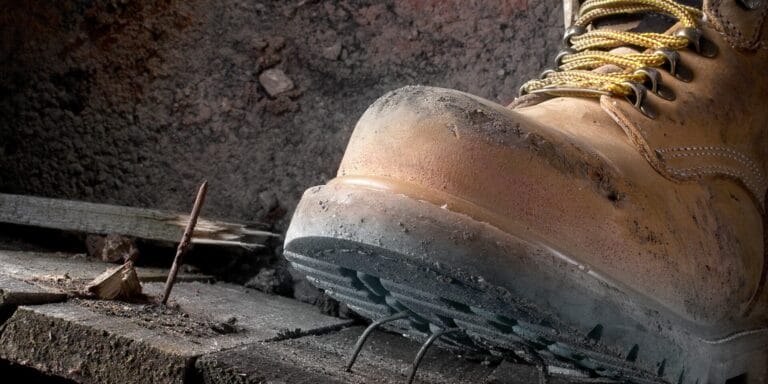The cold months are here, and if you’re a hardworking individual who spends a significant chunk of your day outdoors, you know how important it is to keep warm from head to toe. As you carefully select your winter jacket, gloves, and hat for the upcoming workday, it’s easy to overlook your socks. Yet, these often-underestimated articles of clothing play a major role in ensuring you stay warm and comfortable.
Before we get into the specifics, it’s worth noting why the right work socks matter so much. Your feet are your foundation, and in cold weather, keeping them warm isn’t just about comfort – it’s about safety. Cold feet can give rise to various health issues, including decreased circulation, numbness, and reduced mobility. Such conditions not only compromise comfort but also elevate the risk of injuries.
Understanding the Risk
Being wet and cold for an extended period of time can lead to something called Trench Foot, a serious non-freezing foot condition. Surprisingly, trench foot can happen even when it’s not freezing outside, as long as your feet stay wet. The problem is that wet feet lose heat 25 times faster than dry feet, thus emphasizing the importance of keeping your feet dry during these times to avoid the discomfort and potential harm associated with this condition. Some of the symptoms of trench foot include redness of the skin, tingling, swelling, leg cramps, and blisters.
Frostbite is another condition that occurs when your skin and tissues freeze, which can result in lasting damage to your body. In more severe cases, it might even lead to amputation. Certainly, individuals with poor blood circulation normally have a higher risk of catching frostbite, which is why it is extremely important to consider your clothing choices. Understanding these risk factors can help you take necessary precautions to keep warm and prevent the potentially severe consequences associated with frostbite. Symptoms of frostbite include loss of color and feeling, tingling, and firmness in the affected areas.
Why Sock Materials Matter
When it comes to choosing the right work sock, the type of material is crucial. Among the plethora of options available on the market, several materials stand out for their unique attributes.
Wool Socks have gained widespread recognition for their effectiveness in providing a number of benefits. Wool socks are natural, breathable, and offer excellent insulation properties that help regulate body temperature, keeping feet warm in cold conditions and cool in warmer weather. Additionally, wool has the unique ability to wick moisture away from the skin, absorbing and releasing it into the air, which helps to prevent the development of blisters and discomfort caused by sweat.
For those dealing with diabetes or circulatory issues, Diabetic Socks are a great choice. Crafted with meticulous consideration for the unique needs of those with sensitive health conditions, these socks go beyond conventional materials and design features. They are typically made from a combination of materials, including cotton, which is gentle on sensitive skin. Notably, diabetic socks prioritize comfort and health by incorporating minimal seams and a non-constricting fit, effectively minimizing friction and providing ample room for circulation without causing undue pressure. By combining thoughtful material selection, seamless construction, and a focus on circulatory health, diabetic socks stand as the ideal choice for those navigating the challenges of diabetes.
For more insightful information on navigating these challenges, check out our recent blog titled “Empowering Diabetic Workers in 2023”.
Bamboo Socks are fairly new to the industry and offer a sustainable and comfortable choice for all seasons. These socks excel at moisture-wicking, ensuring dry and comfortable feet, while their softness and hypoallergenic nature minimizes the risk of skin irritation, making these socks an excellent choice for most industries across the board. Bamboo socks adapt to temperature changes, making them suitable year-round, and they’re surprisingly durable.
Balancing Layering & Fit
Layering socks and other clothing can be a crucial strategy for employees working in cold and wet conditions. By incorporating moisture-wicking base layers, insulating mid-layers, and weather-resistant outer layers, employees can create a versatile barrier against the elements. However, it’s paramount to remember in every instance regarding your feet, fit is always a priority. Getting the right fit is just as important as choosing the right sock material and thickness.
Your work socks should be snug but not constricting. A well-constructed work sock should maintain its shape and elasticity allowing it to stay in place throughout the day. These elastic elements at the cuff and instep of the sock, ultimately help prevent discomfort and potential chafing during prolonged use.
Similarly, always make sure to accommodate for the extra layers in work boots. Ill-fitted boots can lead to various issues, particularly when it comes to the safety toe cap. Not only can a tight fit cause discomfort but can also reduce maneuverability, which can heighten the chances of workplace accidents.
By understanding the risks, choosing the right materials, and emphasizing the significance of proper layering and fit, you mitigate the challenges that come along with these work environments – because having cold feet is a risk best avoided!





